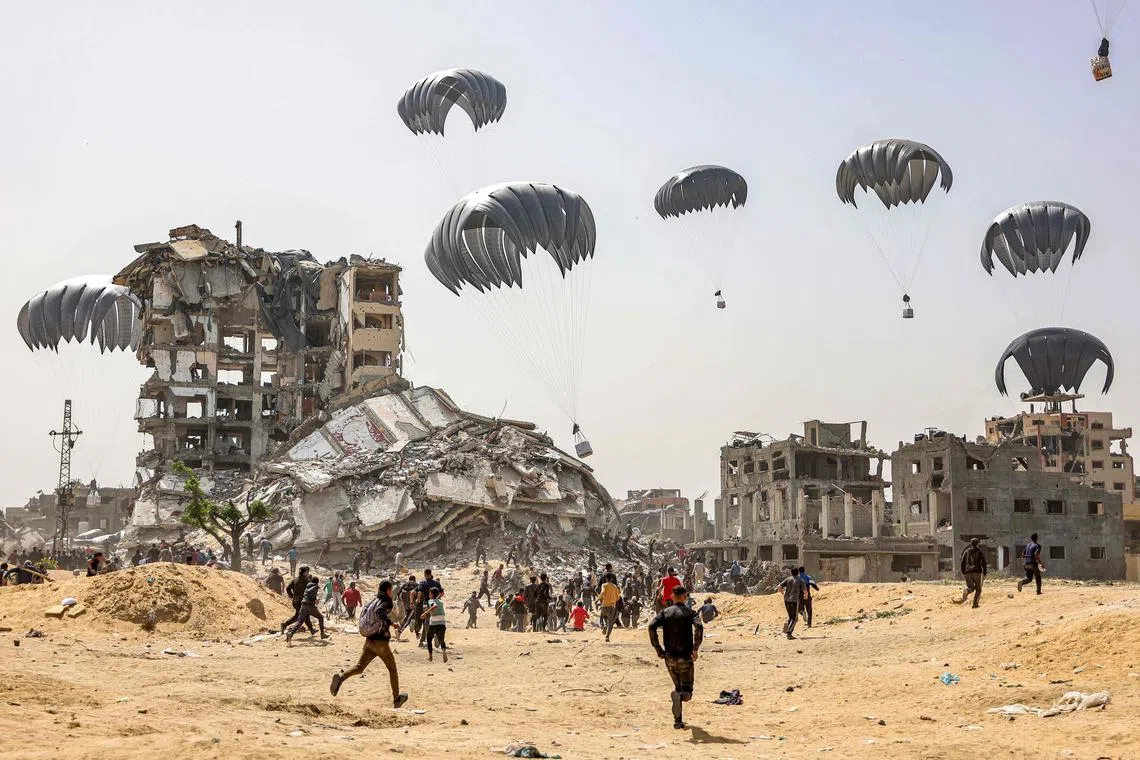Why optimism for a ceasefire in Gaza is rising
Sign up now: Get ST's newsletters delivered to your inbox

People rushing to catch humanitarian aid packages being dropped over the northern Gaza Strip on April 23.
PHOTO: AFP
Follow topic:
Hamas said on Dec 17 that “serious and positive talks”
Officials from countries involved in the talks say both sides might be nearing a truce in the war that began with Hamas’ attacks on Oct 7, 2023. It would be the first pause in the fighting since November 2023 when Israel and Hamas agreed to a week-long ceasefire that gave Palestinians in Gaza a brief reprieve and freed 105 hostages.
But months of negotiations have seen hopes rise repeatedly, only to be dashed days later by a fresh impasse.
Here’s what we know so far.
What’s on the table?
In a change from previous negotiations, both sides have generally refrained from leaking details of the talks to the media. Some analysts said they believed the blackout indicated that Israel and Hamas were more serious about an accord this time around.
According to officials familiar with the talks, mediators have floated a ceasefire beginning with a 60-day truce. During this phase, Hamas would release some of the 100 or so hostages still held in Gaza – some of them dead – in exchange for Palestinians jailed in Israel.
Qatari and Egyptian mediators, who have brokered the talks alongside the United States, hope the initial truce will continue into a permanent ceasefire.
Israel has demanded that its forces largely remain in two segments of Gaza: one, known as the Netzarim corridor, through central Gaza, splitting the northern and southern parts of the enclave; and the other, called the Philadelphi corridor, along the territory’s border with Egypt.
Hamas had previously demanded a swift and complete Israeli exit from the enclave. But the group is now willing to tolerate an extended Israeli presence in parts of those two corridors as long as Israel eventually withdraws, according to a person familiar with Hamas’ thinking.
Why has the war gone on for so long?
For months, Israel and Hamas were deadlocked.
Israeli leaders, including Prime Minister Benjamin Netanyahu, vowed to eradicate Hamas in Gaza after the Oct 7, 2023, attacks killed about 1,200 people in Israel, the deadliest day in the country’s history.
Hamas said it would not release any more hostages unless Israel agreed to end the war, completely withdraw its forces and release scores of Palestinians in Israeli jails.
Qatar and Egypt, as well as the Biden administration, pitched both sides on a three-phase agreement, hoping to build momentum. Those efforts repeatedly broke down.
Israeli critics accuse Mr Netanyahu of putting his own political fortunes and the desires of his political allies above the fate of the hostages. His governing coalition relies on far-right parties that have opposed ending the war, hoping to control Gaza and build Jewish settlements there; they could topple the government if they reject a ceasefire the Prime Minister approves.
Mr Netanyahu says he is doing everything he can to free the hostages, although he has said that he will not compromise on eliminating Hamas.
Hamas has also kept fighting despite the enormously heavy price for Gaza’s civilians: about 45,000 people killed and many more wounded, Gaza health authorities say, and about two million forced from their homes amid widespread destruction. Some Palestinians say Hamas is now battling to salvage its own post-war rule in Gaza, rather than for any larger cause.
What might have changed?
Over the past few months, the momentum in the Middle East has radically shifted, creating what some officials and diplomats are calling favourable conditions for a deal.
In early December, President-elect Donald Trump vowed on social media that there would be “ALL HELL TO PAY” unless the hostages were released by his inauguration on Jan 20. “Those responsible will be hit harder than anybody has been hit,” he wrote.
Many in Israel saw that message as aimed at Mr Netanyahu as well as Hamas. Trump has called on Israel to “finish up” the war, although his vision for a post-war settlement in Gaza remains unclear. The pace of talks accelerated after Mr Steven Witkoff, whom the President-elect has named his Middle East envoy, met Mr Netanyahu and the Qatari Prime Minister in November.
US officials have suggested that Israel has accomplished nearly everything possible through military might in Gaza. Many Israelis are also deeply worried about the fate of the remaining hostages, whose families fear they might not survive another winter in captivity.
At the same time, many of Hamas’ leaders and fighters have been killed, and the group is more isolated than ever. Israeli officials say they hope that could push the group towards a compromise.
Hamas’ ally Hezbollah had insisted that it would keep firing rockets and drones at Israel until it ended the war in Gaza. But after Israel killed many of Hezbollah’s leaders and operatives, the Lebanese militant group buckled and consented to a separate peace deal in November.
Soon afterwards, rebel forces swept into the Syrian capital of Damascus, toppling the decades-long rule of President Bashar al-Assad. Mr Assad was a key ally of Iran, which also backs Hamas and Hezbollah. Both groups now see their patron in retreat across the region.
Hamas’ leaders once dreamed of a regional war against Israel alongside other Iran-backed militias. But they now realise that the “cavalry is not coming to the rescue”, US Secretary of State Antony Blinken said in early December. NYTIMES

